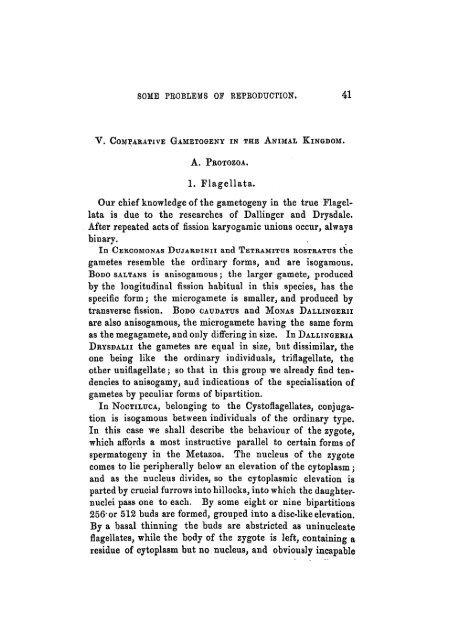Some Problems of Reproduction: a Comparative Study of ...
Some Problems of Reproduction: a Comparative Study of ...
Some Problems of Reproduction: a Comparative Study of ...
Create successful ePaper yourself
Turn your PDF publications into a flip-book with our unique Google optimized e-Paper software.
SOME PROBLEMS OP REPRODUCTION. 41<br />
V. COMPARATIVE GAMETOGENY IN THE ANIMAL KINGDOM.<br />
A. PROTOZOA.<br />
1. Flagellata.<br />
Our chief knowledge <strong>of</strong> the gametogeny in the true Flagellata<br />
is due to the researches <strong>of</strong> Dallinger and Drysdale.<br />
After repeated acts <strong>of</strong> fission karyogamic unions occur, always<br />
binary.<br />
In CEKCOMONAS DUJARDINII and TETRAMITUS ROSTRATUS the<br />
gametes resemble the ordinary forms, and are isogamous.<br />
BODO SALTANS is anisogamous; the larger gamete, produced<br />
by the longitudinal fission habitual in this species, has the<br />
specific form; the microgamete is smaller, and produced by<br />
transverse fission. BODO CAUDATUS and MONAS DALLINGERII<br />
are also anisogamous, the microgamete having the same form<br />
as the megagamete, and only differing in size. In DALLINGERIA<br />
DRYSDALII the gametes are equal in size, but dissimilar, the<br />
one being like the ordinary individuals, triflagellate, the<br />
other uniflagellate; so that in this group we already find tendencies<br />
to anisogamy, and indications <strong>of</strong> the specialisation <strong>of</strong><br />
gametes by peculiar forms <strong>of</strong> bipartition.<br />
In NOCTILUCA, belonging to the Cyst<strong>of</strong>lagellates, conjugation<br />
is isogamous between individuals <strong>of</strong> the ordinary type.<br />
In this case we shall describe the behaviour <strong>of</strong> the zygote,<br />
which affords a most instructive parallel to certain forms <strong>of</strong><br />
spermatogeny in the Metazoa. The nucleus <strong>of</strong> the zygote<br />
comes to lie peripherally below an elevation <strong>of</strong> the cytoplasm;<br />
and as the nucleus divides, so the cytoplasmic elevation is<br />
parted by crucial furrows into hillocks, into which the daughternuclei<br />
pass one to each. By some eight or nine bipartitions<br />
256or 512 buds are formed, grouped into a disc-like elevation.<br />
By a basal thinning the buds are abstricted as uninucleate<br />
flagellates, while the body <strong>of</strong> the zygote is left, containing a<br />
residue <strong>of</strong> cytoplasm but no nucleus, and obviously incapable

















